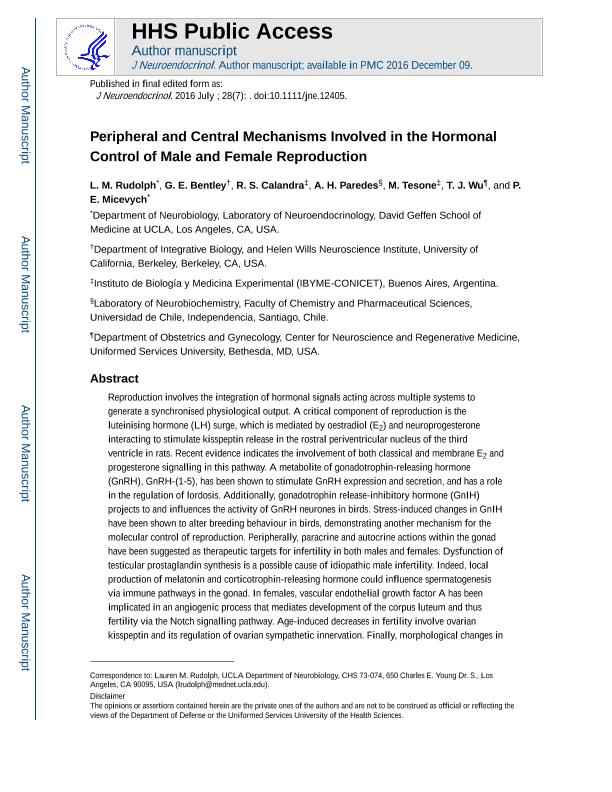Artículo
Peripheral and central mechanisms involved in hormonal control of male and female reproduction
Rudolph, L. M.; Bentley, G. E.; Calandra, Ricardo Saul ; Paredes, A. H.; Tesone, Marta
; Paredes, A. H.; Tesone, Marta ; Wu, T. J.; Micevych, P. E.
; Wu, T. J.; Micevych, P. E.
 ; Paredes, A. H.; Tesone, Marta
; Paredes, A. H.; Tesone, Marta ; Wu, T. J.; Micevych, P. E.
; Wu, T. J.; Micevych, P. E.
Fecha de publicación:
20/07/2016
Editorial:
Wiley
Revista:
Journal of Neuroendocrinology
ISSN:
0953-8194
e-ISSN:
1365-2826
Idioma:
Inglés
Tipo de recurso:
Artículo publicado
Clasificación temática:
Resumen
Reproduction involves the integration of hormonal signals acting across multiple systems togenerate a synchronized physiological output. A critical component of reproduction is the luteinizinghormone (LH) surge, which is mediated by estradiol (E2) and neuroprogesterone interacting tostimulate kisspeptin release in the rostral periventricular nucleus of the third ventricle in rats. Recentevidence has shown that both classical and membrane E2 and progesterone signaling is involved inthis pathway. A metabolite of gonadotropin-releasing hormone (GnRH), GnRH-(1-5), has been shownto stimulate GnRH expression, secretion, and has a role in the regulation of lordosis. Additionally,gonadotropin-inhibitory hormone (GnIH) projects to and influences the activity of GnRH neurons inbirds. Stress-induced changes in GnIH have been shown to alter breeding behaviors in birds,demonstrating another molecular control of reproduction. Peripherally, paracrine and autocrineactions within the gonad have been suggested as therapeutic targets for infertility in both males andfemales. Dysfunction of testicular prostaglandin synthesis is a possible cause of idiopathic maleinfertility. Indeed, local production of melatonin and corticotropin-releasing hormone (CRH) couldinfluence spermatogenesis via immune pathways in the gonad. In females, vascular endothelialgrowth factor A (VEGF-A) has been implicated in an angiogenic process that mediates developmentof the corpus luteum and thus fertility via the Notch signaling pathway. Age-induced decreases infertility involve ovarian kisspeptin and its regulation of ovarian sympathetic innervation. Finally,morphological changes in the arcuate nucleus of the hypothalamus influence female sexualreceptivity in rats. The processes mediating these morphological changes have been shown toinvolve rapid effects of E2 controlling synaptogenesis in this hypothalamic nucleus. Together, thisreview highlights new research in these areas, focusing on recent findings in the molecularmechanisms of central and peripheral hormonal control of reproduction.
Palabras clave:
Progesterone
,
Androgens
,
Paracrine
,
Autocrine
Archivos asociados
Licencia
Identificadores
Colecciones
Articulos(IBYME)
Articulos de INST.DE BIOLOGIA Y MEDICINA EXPERIMENTAL (I)
Articulos de INST.DE BIOLOGIA Y MEDICINA EXPERIMENTAL (I)
Citación
Rudolph, L. M.; Bentley, G. E.; Calandra, Ricardo Saul; Paredes, A. H.; Tesone, Marta; et al.; Peripheral and central mechanisms involved in hormonal control of male and female reproduction; Wiley; Journal of Neuroendocrinology; 28; 7; 20-7-2016; 1-12
Compartir
Altmétricas



